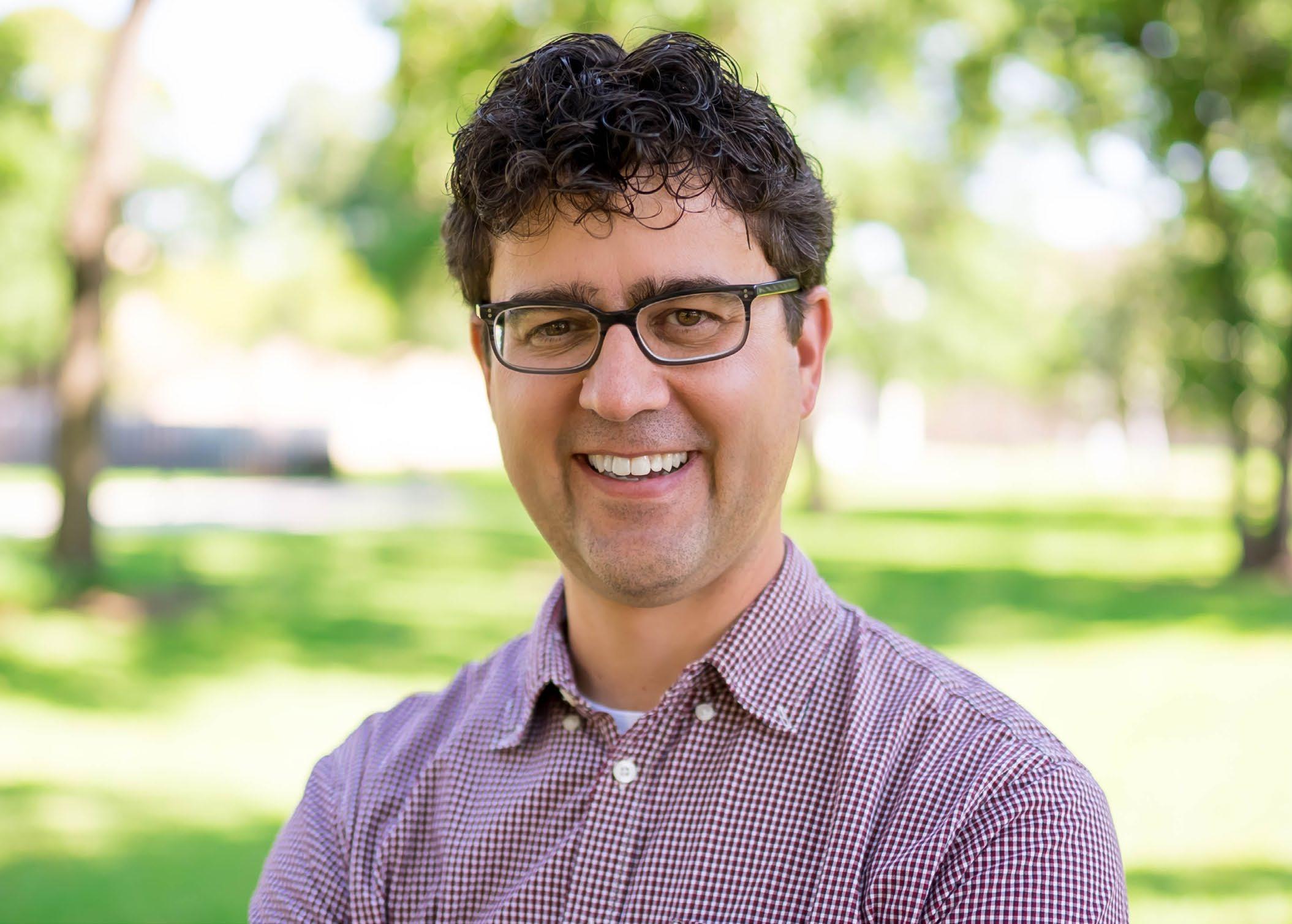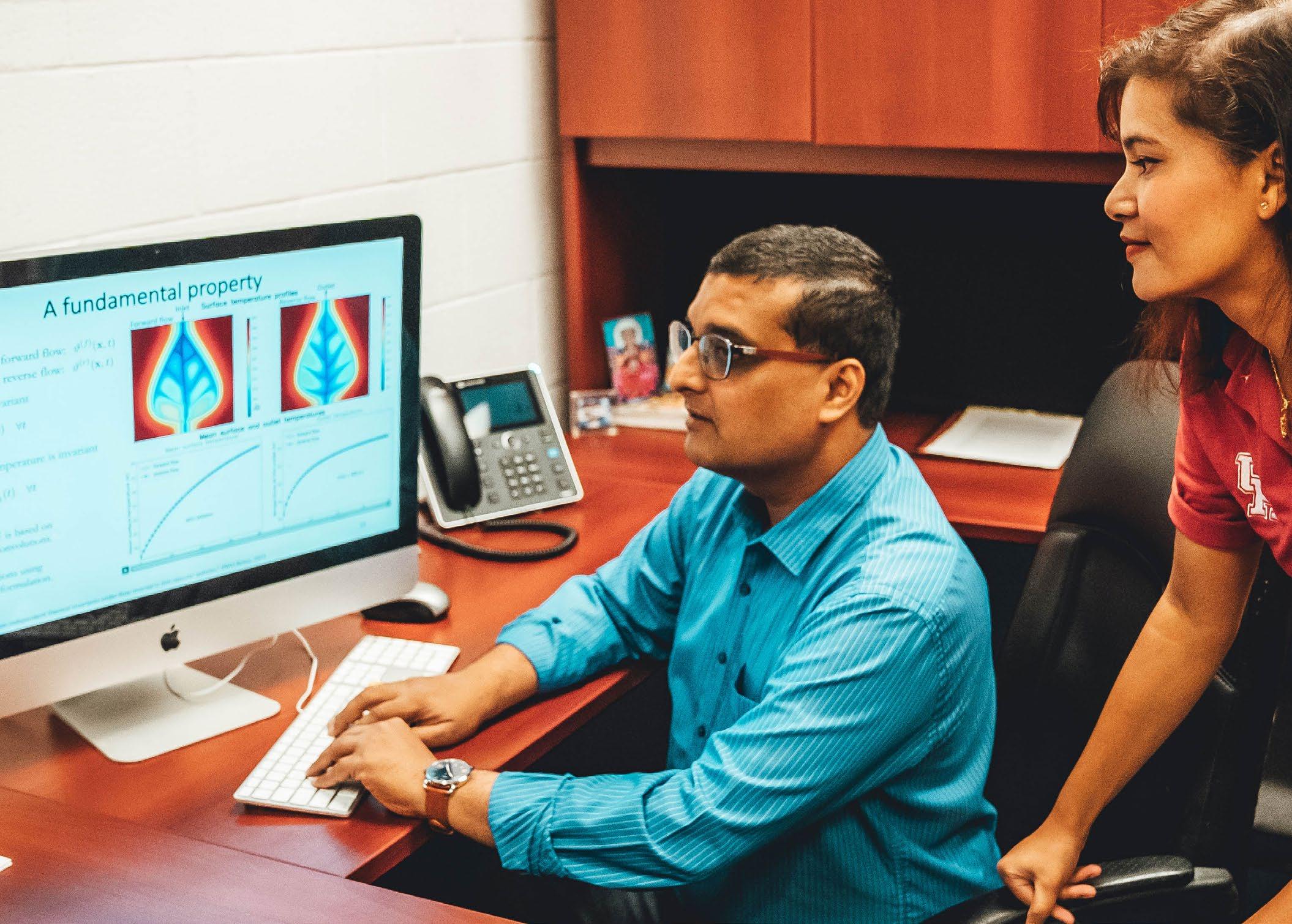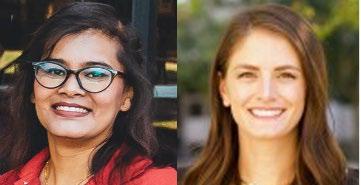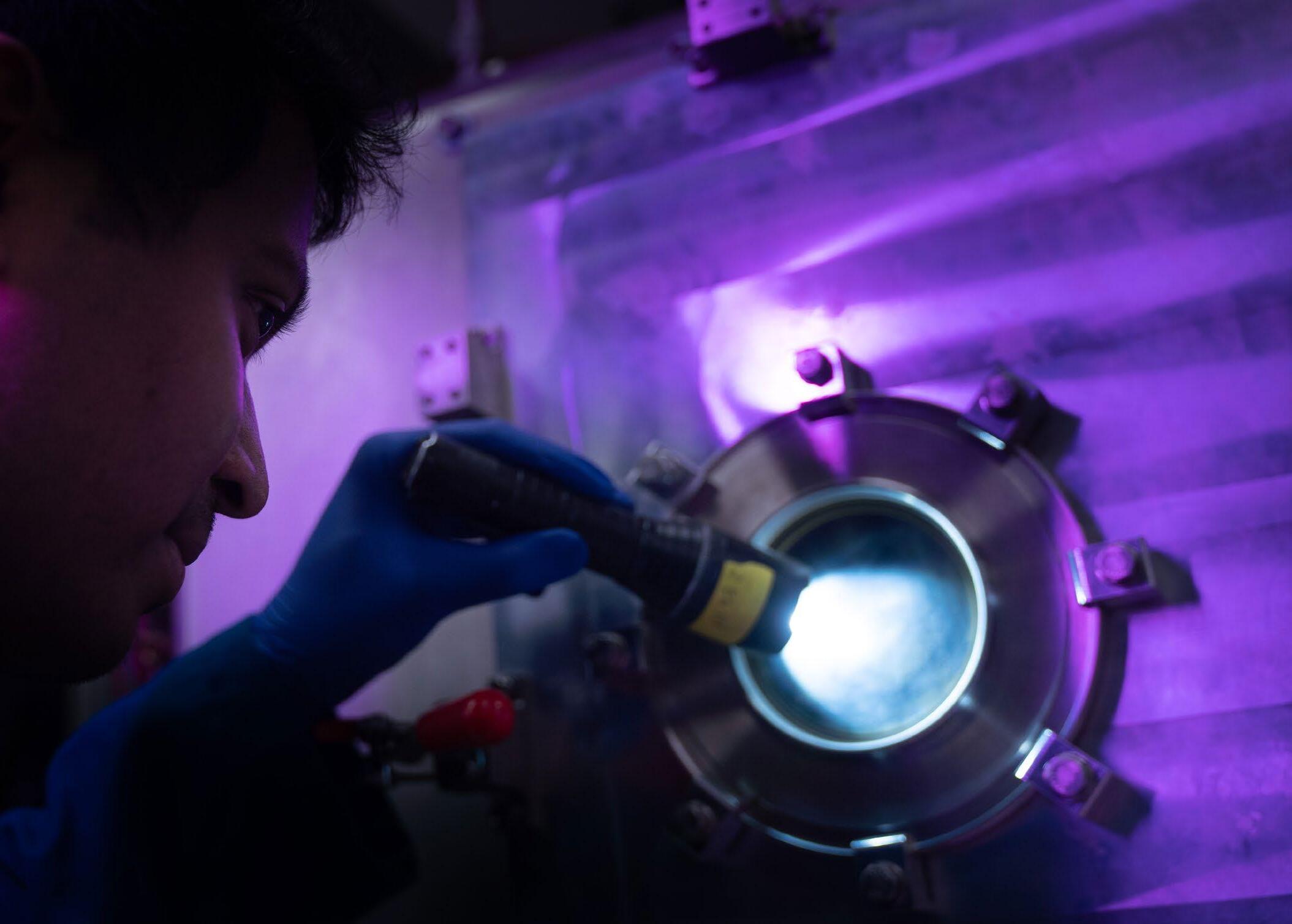Civil and Environmental Engineering
Newsletter SPRING 2024


Newsletter SPRING 2024


Dear Colleagues,
Greetings from the UH Civil and Environmental Engineering Department!
The last six months have been a very busy time for our department. I invite you to explore the following stories which represent a small sampling of the exciting work being done by our faculty and students. If you see opportunities for collaboration, do not hesitate to reach out, and I invite you come and visit whenever you have a chance.
Warm Regards,
Roberto
Ballarini, Ph.D., P.E. Thomas and Laura Hsu Professor and Department ChairCivil and Environmental Engineering
Cullen College of Engineering
University of Houston
1 NATIONAL ACADEMY OF ENGINEERING MEMBER FACULTY (FALL 2023)
DEGREES AWARDED (FY 2023)
75 B.S.
ENROLLMENT (FALL 2023)
465
139 UNDERGRADUATE STUDENTS GRADUATE STUDENTS
42 M.S.
4 PH.D.

The University of Houston has been awarded a $63.5 million contract by the U.S. Department of Defense to help the Army make effective and timely decisions with a strong analytical foundation to gain dominance over adversaries today and into the future. It is the largest contract or grant ever awarded to the University of Houston, a Carnegie-designated Tier One research university located in the fourth largest city in the nation.
Craig Glennie, professor of civil and environmental engineering and director of engineering defense research initiatives at the UH Cullen College of Engineering, is leading the project team that includes the University of Massachusetts Amherst and New Mexico State University, among others.
The team will explore and innovate in the realm of analytical modeling and simulation to enhance the Army’s decision making during long-term strategic competition or struggles among nations that occur when pursuing incompatible interests without necessarily being engaged in armed conflict.
Contemporary Army decision-making bears little resemblance to its historical counterparts. The Army is undergoing
the most significant reorganization and technical innovation since the end of the Cold War — ensuring that adversaries cannot outrange or outpace America on traditional battlefields, or the new frontiers of space and cyberspace.
Glennie’s team will work with the U.S. Army Combat Capabilities Development Command (DEVCOM) Analysis Center (known as DAC) to build realistic modeling, analysis and simulation tools for new technologies that the Army is responsible for integrating into the future battlefield.

As the “Energy University” committed to shepherding an efficient and innovative energy transition, the University of Houston is offering a timely micro-credential course focused on artificial intelligence and robotics for energy integrity and maintenance. The course, titled “AI & Robotics for Energy Integrity,” runs from March 22 - April 12, 2024.
“As industries increasingly adopt AI and robotics for various applications, the demand for skilled professionals who understand these technologies is growing. This course aims to equip participants with the essential skills,” said Vedhus Hoskere, assistant professor at the UH Cullen College of Engineering, who will be teaching the module titled “Computer Vision and Deep Learning for Inspections.” Hoskere was recently awarded a grant for a project exploring how to best leverage technology like drones, cameras, sensors and AI to gather data about bridges and use it to make critical deci-
sions and improve safety. Course attendees will gain valuable insights covering, but not limited to:
• Efficiency through Robotics
• Data Analysis and Management
• Revolutionizing Inspection Methodologies
“By blending theoretical knowledge with practical applications and hands on experience, the course aims to empower participants with the skills needed to evaluate and adopt these advanced technology to address real-world challenges in asset management,” Hoskere said. “We hope that upskilling and knowledge gained from this course will help accelerate the adoption of AI and robotics and contribute to the advancement of safer and more resource efficient energy infrastructure systems.”
 Pictured: Industries are increasingly adopting AI and robotics for various applications, including energy infrastructure operations and maintenance.
University of Houston
Pictured: Industries are increasingly adopting AI and robotics for various applications, including energy infrastructure operations and maintenance.
University of Houston

Mim Rahimi, assistant professor of environmental engineering, has earned an NSF CAREER Award for his work focused on leveraging liquid interfaces for innovative electrochemical carbon capture. Dr. Rahimi joined the Cullen College of Engineering in the 20212022 academic year. Prior to coming to UH, he was a postdoctoral associate in the Department of Chemical Engineering at MIT from 2018 to 2021. He completed his doctorate at Penn State in 2017. In his lab, electrochemical processes are being developed to help industries become more energy-efficient and to capture CO2 from either point sources or air.

Konrad Krakowiak, assistant professor in the Civil and Environmental Engineering Department at the University of Houston’s Cullen College of Engineering, is quick to defer when he’s offered praise for his research. For him, any success he might have is due to the students he has working with him, and the critical thought process foundation he got from his academic mentors.
His latest “great achievement,” as he considers it, is earning a National Science Foundation CAREER award for his proposal, “Stereochemical Biomimicry for Sustainability.” The $698,187 in funding is the second significant NSF grant for Krakowiak, after earning $203,151 for similar research in 2018. The main focus of Krakowiak’s research group is implementing practical modifications for construction materials by examining and improving them on the molecular scale.

Juan Carlos Fernandez-Diaz, a research assistant professor in the Civil and Environmental Engineering Department and a co-investigator for the National Center for Airborne Laser Mapping (NCALM), is part of the 2023-25 cohort for the American Geophysical Union (AGU) LANDInG Academy Fellows.
The LANDInG Academy is a two year program aimed at providing mid faculty with a network, tools and resources to achieve more balanced representation in geosciences. Fernandez-Diaz joined UH in 2010 as a senior researcher for the NCALM, after earning his doctorate in Geosensing Systems Engineering from the University of Florida. He became a research assistant professor in 2019.
An assistant professor at the Cullen College of Engineering has been awarded a three-year, $505,286 grant from the Texas Department of Transportation (TxDOT) to advance research on digitizing bridges using robots, data and artificial intelligence (AI). The efforts will help solve complex problems relating to highway bridge safety.
Vedhus Hoskere, an assistant professor in the Civil and Environmental Engineering Department, is the lead PI for the research award. His project, “Development of Digital Twins for Texas Bridges,” began in September, with research running through August 2026. Hoskere noted that their ultimate goal was to increase the efficiency and effectiveness of the state’s bridge maintenance.
This is the first TxDOT project that Hoskere will be working on. “We have been researching developing digital twins for
inspections and management of various infrastructure assets over the past 8 years. This project provides us an opportunity to leverage our expertise to help TxDOT achieve their goals while also advancing the science and practice of better developing these digital twins,” he said.
Hoskere also chairs the sub task group of the International Association for Bridge and Structural Engineering (IABSE) TG5.9, ST2.2 on AI methodologies for typical pathologies/ degradation identification for remote inspection of bridges” Our international efforts align closely with this project’s goals. The insights gained globally will enhance our work in Texas, while our research at UH contributes to advancing bridge digitization worldwide.
 Pictured: Vedhus Hoskere
University of Houston | Cullen College of Engineering
Pictured: Vedhus Hoskere
University of Houston | Cullen College of Engineering
Mim Rahimi, assistant professor of environmental engineering at UH’s Cullen College of Engineering is leading the development of an emerging NET called electrochemical direct ocean capture (eDOC), which helps the ocean cleanse itself of harmful carbon dioxide. The concept is detailed in a paper published in the journal Energy & Environmental Science.
“Electrochemical direct ocean capture amplifies the ocean’s ability to absorb carbon, sidestepping the expensive sorption process typical in many current strategies,” Rahimi said. “The promise of eDOC is undeniable, but scaling it, optimizing costs and achieving peak efficiency remain challenges we’re actively addressing.”
Funded by a $250,000 grant from the U.S. Department of Energy, Rahimi and his team are working to create electrochemical tubes to remove dissolved inorganic carbon from synthetic seawater. Preliminary research on the project was sponsored by UH’s Center for Carbon Management in Energy.
Current efforts to remove carbon dioxide from the ocean mainly involve complex processes like electrolysis, which attempt to either turn dissolved inorganic carbon into gas or convert it into magnesium or calcium carbonates. However, these techniques are energy-intensive and costly due to the use of rare and expensive materials, such as platinum and specialized membranes that easily clog, degrading their performance.
 Pictured: Mim Rahimi, assistant professor (center) with his doctoral students (left to right) Prince Aleta, Mohsen Afshari, Abdelrahman Refaie and Ahmad Hassan.
University of Houston
Pictured: Mim Rahimi, assistant professor (center) with his doctoral students (left to right) Prince Aleta, Mohsen Afshari, Abdelrahman Refaie and Ahmad Hassan.
University of Houston


In an attempt to better regulate temperature in a variety of synthetic structures and gain a deeper understanding of biological systems, a newly published paper by researchers from the Cullen College of Engineering’s Civil and Environmental Engineering Department finds some surprising conclusions about using fluids to control temperature.
“Configuration-independent thermal invariants under flow reversal in thin vascular systems” was published recently in PNAS Nexus. Its lead author is Kalyana Nakshatrala, associate professor and associate chairman of the Civil and Environmental Engineering Department and Kripa Adhikari, a doctoral student of Nakshatrala at UH.
Much like how mammals and birds regulate their body temperature through the circulation of blood in their vascular systems, we aim to mimic a similar mechanism in the synthetic world,” he said. “We want to modulate temperature by flowing a fluid through a network of vesicles embedded within the body. Surprisingly, we found several symmetries or invariances – Swapping the locations of the fluid’s inlet and outlet does not alter thermal efficiency.
Nakshatrala and Adhikari said, “Several related research initiatives are currently underway utilizing and extending the findings presented in the paper. These endeavors span mathematical analysis, design optimization, and additive manufacturing with an overarching goal of mimicking nature and bringing various thermal regulation and active-cooling strategies to the synthetic world. Stay cool!”

 Pictured: Juan Carlos Fernandez-Diaz, co-principal investigator of NCALM
CIVIL AND ENVIRONMENTAL ENGINEERING
Pictured: Juan Carlos Fernandez-Diaz, co-principal investigator of NCALM
CIVIL AND ENVIRONMENTAL ENGINEERING

In the ongoing quest to unearth the world’s hidden mysteries, University of Houston researchers and archaeology partners have discovered a lost Maya city deep in the jungles of Campeche, on the Yucatan Peninsula, in Mexico. Notable among the findings were several 50-foot-tall structures, resembling pyramids, and pottery that dates the city to the Late Classic period, between the years 600 and 800.
Though undeniably rare and incredibly fascinating, finding the city, now dubbed Ocomtún, or stone column in Maya, is all in a day’s work for Juan Carlos Fernandez-Diaz, co-principal investigator of the National Center for Airborne Laser Mapping (NCALM) at UH. “For Mexico and Central America, we are the premier research center that has been able to do this quickly and affordably. We have over ten years of these kinds of these discoveries,” says Fernandez-Diaz.
University of Houston, the Energy University, is proud to introduce the inaugural cohort of UH-Chevron Energy Graduate Fellows – eight graduate students who are actively involved in innovative energy-related research across the UH campus. Funded by Chevron, the program supports graduate students’ research efforts through a one-year, $12,000 fellowship which includes mentoring by faculty experts and the opportunity to engage with subject matter experts at Chevron.
Kripa Adhikari is a Ph.D. student in the Department of Civil and Environmental Engineering in the Cullen College of Engineering. Working under the mentorship of Professor Kalyana Babu Nakshatrala, she has been engaged in pioneering research involving thermal regulation and its practical implications in real-world scenarios and in the field of emerging green energy solutions, specifically enhanced geothermal systems (EGS).
Erin Picton is an environmental engineering Ph.D. student in the Shaffer Lab at UH where she studies membrane separations for water treatment and renewable energy applications, especially pertaining to lithium resources. In addition, as a senior TEX-E fellow, Picton works with a cohort of Texas students in collaboration with MIT and Greentown Labs to build an entrepreneurship ecosystem around sustainable energy innovation.




Kripa Adhikari, a doctoral candidate at the Cullen College of Engineering, traveled to New Mexico in July to present her research on thermal cooling, after earning a travel award for the 17th U. S. National Congress on Computational Mechanics (USNCCM).
Adhikari earned her B.E. in Civil Engineering from Tribhuvan University in Nepal. She worked as a civil engineer for the government of Nepal following her graduation, but she decided to further her education from there.
When asked how her research has impacted her career plans, Adhikari spoke about the ideal career path would be working in the research and development at a technology compnay.
“Given that my research focuses on optimization of materials using multi-physics simulation and computational heat transfer, whose application is relevant in addressing system’s overheating, my ideal career path would be working in research and development at a prestigious technology company,” she said.”


The Houston Mayor and the City Council have appointed Mackrena L. Ramos, P.E., to the City Park Redevelopment Authority and Tax Reinvestment Zone #12 Board of Directors.
Ramos is a Vice President with Lockwood, Andrews & Newnam, Inc. (LAN), which is a planning, engineering and program management firm headquartered in Houston. She is also a graduate of the Civil Engineering program at the University of Houston’s Cullen College of Engineering.
At LAN, Ramos leads the Surface Water Transmission Program (SWTP). She has extensive experience with capital improvement planning, design quality, cost reduction reviews and optimal phasing of improvements for infrastructure projects. A licensed professional engineer, she is a graduate of the University of Houston and holds a bachelor’s degree in civil engineering.
Ramos is an active member of the American Water Works Association, American Society of Civil Engineers, Texas Water Conservation Association, and Houston Hispanic Architects & Engineers.
University of Houston | Cullen College of Engineering
The University of Houston Cullen College of Engineering addresses key challenges in energy, healthcare, infrastructure, and the environment by conducting cuttingedge research and graduating hundreds of world-class engineers each year. With research expenditures topping $40 million and increasing each year, we continue to follow our tradition of excellence in spearheading research that has a real, direct impact in the Houston region and beyond.


UH Cullen College of Engineering
Civil and Environmental Engineering
Engineering Building 1, Room N107
4226 Martin Luther King Boulevard
Houston, TX 77204-4003
@UHEngineering